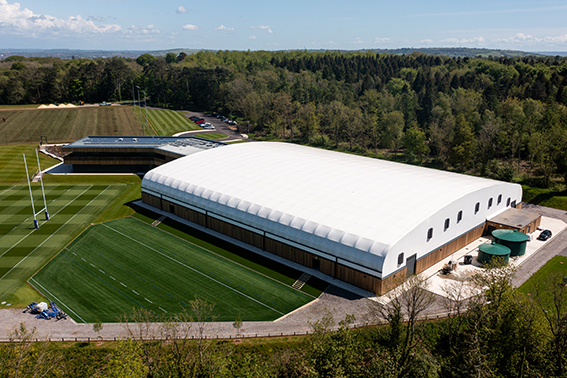The Advantages of Rigid Frame Structures

Rigid frame structures have become a preferred choice in modern construction, thanks to their combination of strength, adaptability, and innovative design possibilities. When paired with advanced technologies like tensile fabric systems, these structures offer unparalleled functionality and aesthetic appeal for a wide range of applications.
Here at Collinson Tensile, we have been making steel rigid frame structures across sports and industry for over 20 years, so we wanted to highlight the benefits of choosing rigid frame structures. In this article, we’ll explore the defining features of rigid frame structures, their benefits, and how they stand out in today’s architectural landscape.
What is a Rigid Frame Structure?
A rigid frame structure is a type of building framework where beams and columns are connected with rigid joints, enabling the structure to resist bending and deformation under load. Unlike traditional designs that rely on walls or additional bracing for stability, rigid frame systems use their interconnected framework to evenly distribute forces, making them strong and self-supporting.
These structures are typically made of materials like steel or reinforced concrete, chosen for their strength and durability. Rigid frames are particularly suited to projects requiring open interior spaces, such as warehouse construction, sports & leisure facilities, and industrial building projects.
What are the Three Types of Frame Structures?
Frame structures in construction can generally be categorised as follows:
- Rigid Frame Structures: Known for their fixed connections, these systems are designed to handle both vertical and horizontal loads efficiently. They are commonly used in large-scale projects requiring open layouts and durability.
- Braced Frame Structures: These systems include diagonal bracing elements to counter lateral forces like wind or earthquakes. While effective for stability, they limit interior layout flexibility.
- Load-Bearing Structures: A more traditional approach, load-bearing structures rely on walls for support and are better suited to smaller buildings with simpler designs.
What are the Advantages of Rigid Frame Structures?
Rigid frame structures offer a wealth of benefits that make them a leading choice in modern construction:
1. Strength and Durability
Rigid frames are engineered to withstand extreme conditions, from high winds to heavy snow loads. Steel versions, in particular, offer exceptional strength while maintaining a relatively lightweight profile. Concrete rigid frame structures, meanwhile, provide excellent resistance to compressive forces, making them ideal for long-lasting construction.
2. Design Versatility
These structures allow for expansive clear spans, often exceeding 90 meters, without the need for interior columns. This design freedom is invaluable for projects like sports arenas, storage facilities, and industrial complexes where uninterrupted space is critical.
3. Efficient Construction
Many rigid frame components are prefabricated off-site, streamlining the assembly process and reducing construction time. This efficiency translates into cost savings, faster project timelines, and reduced on-site disruptions.
4. Enhanced Compatibility
Rigid frame structures integrate seamlessly with modern innovations like tensile fabric systems. By combining the strength of a rigid steel or concrete frame with lightweight fabric membranes, buildings can achieve excellent energy efficiency, natural lighting, and striking aesthetics.
5. Low Maintenance
When treated with protective coatings, rigid frame materials like steel can resist corrosion for decades. This minimises upkeep costs and ensures the structure maintains its integrity over time.
Considerations Before Choosing Rigid Frame Structures?
Although rigid frame systems have many advantages, there are some considerations to keep in mind:
- Higher Initial Costs: Rigid frame systems typically involve greater upfront investment compared to simpler structures. However, their durability and low maintenance often offset this over the lifecycle of the building.
- Engineering Complexity: These systems require precise design and analysis to ensure stability, particularly for large-scale or complex projects.
Rigid Frame vs. Braced Frame: What’s the Difference?
Rigid frame systems and braced frames differ primarily in how they handle forces. Rigid frames rely on the stiffness of their connections to resist lateral and vertical loads, offering open interiors and flexibility in design. Braced frames, on the other hand, use diagonal elements to provide lateral stability, making them simpler to construct but less adaptable in layout.
Which is Better: Load-Bearing or Frame Structures?
The choice between load-bearing and frame structures depends on the needs of the project:
- Load-Bearing Structures: Ideal for small, low-rise buildings with simple layouts, as they rely on walls for support.
- Frame Structures: Provide superior flexibility, strength, and scalability, making them a better fit for modern, large-scale applications like warehouses, sports facilities, and industrial complexes.
Why Rigid Frame Structures Pair Perfectly with Tensile Fabric Systems

Rigid frame systems are often combined with tensile fabric technology to create buildings that are not only functional but also sustainable and visually striking.
Tensile fabric buildings use lightweight, tensioned membranes supported by the rigid frame to create structures with a reduced environmental footprint. These systems maximise natural light, reduce energy consumption, and allow for innovative architectural designs.
At Collinson Tensile, we specialise in integrating steel rigid frames with advanced tensile fabric systems, delivering robust, versatile solutions for industrial, sports, and commercial applications. Our expertise ensures that every structure we build stands the test of time, even in the harshest environments.
Final Thoughts
Rigid frame structures are a testament to the possibilities of modern engineering and design. They combine unmatched strength, adaptability, and efficiency, making them a cornerstone of contemporary construction. When paired with tensile fabric systems, these structures reach new heights of sustainability and innovation.
For businesses or organisations seeking a durable, efficient, and visually appealing solution, rigid frame systems represent an investment in the future. At Collinson Tensile, we’re here to help bring your vision to life with world-class designs and precision engineering. Let’s build something great together.
